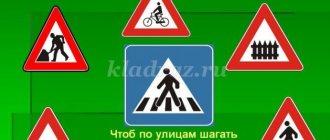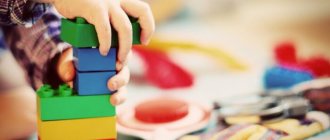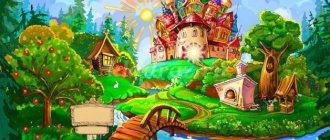Planning for Safety Week (JUNIOR)
I approve
Head of MBDU "Solnyshko"
Varenik N.A.
The most important thing is the health and life of the child.
Preschool age is the most important period when human personality is formed. It is very difficult to determine whether a person behaves correctly or incorrectly in certain circumstances. However, it is necessary to highlight rules of conduct that children must strictly follow, since their health and safety depend on this.
These rules should be explained to children in detail and then monitored for their implementation. However, safety and a healthy lifestyle are not just the sum of acquired knowledge, but a lifestyle, adequate behavior in various situations.
Junior group.
| No. | Subjects | Approximate activity content | Interaction with family | Responsible |
| MONDAY | “Be careful, dear children! Remember these rules firmly!” (safety rules in kindergarten, on the street, in nature) |
| Advertising for Safety Week. Design of a stand “Dangerous situations at home and in kindergarten” or similar. | Senior teacher, music director, educators, employees of social institutions, parents |
| TUESDAY | “To prevent trouble from coming to your home, always be careful with fire!” (fire safety rules) |
| Help in creating a file cabinet “Fire Safety Rules in Poems and Pictures” | |
| WEDNESDAY | “Learn and respect the traffic rules!” (safety rules behavior on the road and in transport) |
| Memos or booklets “Parent-driver, remember!”, “Rules for transporting children”, etc. | |
| THURSDAY | “When I’m home alone...” (house rules) |
| Design of a stand “Dangerous situations at home and in kindergarten” or similar | |
| FRIDAY | “If you’re healthy, you’ll get everything” |
help"
| . | |
| Report forms: | ü Multimedia presentation (photo slides with text); ü Design of a photo exhibition (wall newspaper) for parents; ü Preparation of materials for the website. |
Recommended Internet resources:
https://zanimatika.narod.ru/OBJ_odin_doma.htm
https://vospitatel-enm.ru/igra-viktorina-znatoki-pravil-bezopasnosti
https://doulavrovo.ru/pozharnaya-bezopasnost-v-dou
https://vdohnovlennye.ru/?page_id=264
https://apruo.ru/doshkolnoe-obrazovanie/zanyatiya-s-doshkollnikami/474-nedelya-bezopasnosti-v-detskom-sadu-kogda-ya-odin-doma.html
https://nsportal.ru/detskiy-sad/raznoe/2013/03/09/provedenie-nedeli-zdorovya-nedeli-bezopasnosti
Thematic week “The ABC of Safety”
Materials and equipment:
multimedia presentation “Fire - friend or foe?”;
recording the sounds of burning flames; musical recording by Khachaturian “Sabre Dance” for the plastic sketch “What is fire like?”; pictures depicting various situations where fire is useful or harmful; plumes for dancing; paraphernalia for relay races: 2 buckets, 2 substitute fire extinguishers, 2 shovels, 2 dolls, 2 children's buckets, 2 children's blankets. Progress:
Introduction to the game situation
. Children are sitting on the carpet. The teacher suggests listening to the recording of sounds and guessing what it is. (The fire is burning). “Guys, what do you think, does a person need fire or not? Is fire our friend or enemy? (As a rule, children answer differently. All answer options are accepted by the teacher. You should try to create a friendly atmosphere for discussion.) Next, the teacher suggests learning as much as possible about fire and then answering this question again.
Main part.
The teacher tells the children the story of the origin of fire, accompanied by a multimedia presentation and involving children in the story. Then he sums it up: “Fire brings many benefits to man. But if people are careless when handling fire, it can cause harm. And then forests burn and animals die (slide show), houses can catch fire and people get hurt (slide).
Did. game “Fire is a friend, fire is an enemy.” Children are divided into two teams. One team chooses pictures where fire helps people, the other where fire causes harm, and justify their choice.
Plastic sketch “What kind of fire is there?” Children dance with the sultans to a musical recording of Khachaturian’s melody “Sabre Dance”, trying to convey the character of music and fire.” After the dance, the teacher asks the children: “What kind of lights were you: good, beneficial to humans, or harmful and dangerous?”
Did game "Yes-no". The teacher invites the children to formulate together the rules for handling fire and behavior in case of fire. If the children agree with the statement, they clap their hands; if they disagree, they stomp their feet. Suggestions could be: if there is a fire in the apartment, you need to quickly hide under the bed; in case of fire, call 01; if you see a fire, you must urgently inform adults and leave the premises; you can quietly take matches and play, etc.
A conversation about the profession of a firefighter is accompanied by a presentation. Children are active participants in the discussion. The teacher asks questions: Who puts out fires? What does a fire truck look like? What kind of person should a firefighter be? (strong, brave, kind, courageous, good, courageous, etc.) How can you put out a fire? (with water, cover with sand or earth, a fire extinguisher, a thick blanket).
Outdoor game "Firefighter Training". Children are divided into two teams. Firefighters must put out the house and save the child from the fire. The first couple takes the “child” doll out of the “burning house” and wraps him in a blanket. The second pair “puts out the fire” with water, using children’s buckets. The third pair is “covering the fire with sand” - imitation of actions using blades. The fourth pair - “extinguishes with a fire extinguisher” - a substitute object (pin) is used.
Summing up, reflection.
The teacher invites the children to answer the question again: Does a person need fire or not? Still, is fire a friend of people or an enemy? Summing up: “Man needs fire; it brings many benefits. Man cannot refuse to use fire. And to avoid trouble, you need to follow the rules of handling fire and always be careful.
Some children's drawings made during Safety Week.
Children's knowledge gained
secured by making
collages based on fairy tales.
“The fairy tale is a lie, but there is a hint in it,
Good fellows have a lesson..."
Quickly take the steering wheel in your hands and start the engine. Let's pump up the tires together and get into the cars together. We press the pedal and the car goes into the distance.
Stop, car, stop, engine! There is a traffic light on the road. The red light comes on - that means there is no way for us! Yellow - be careful!
And the green light is on, which means the path is open again.
open.
Our traffic lights:
from cubes,
designer, mosaic.
In physical education we learned how to fight germs and diseases.
Bibliography.
1. Alyabyeva E.A. Thematic days and weeks in kindergarten: Planning and notes. - M.: TC Sfera, 2005.
2. Afonkin S. When, why and why? St. Petersburg: Lan, 1996.
3.Safety of your baby. A popular guide for children and parents. "Development Academy" 1997.
4. Ivanov Albert The ABC of Safety: How inseparable friends did not burn in the fire;
How inseparable friends did not drown in the water;
How inseparable friends guarded the house;
How inseparable friends crossed the road “Ast-press”, Moscow, 1996.
5. Internet resource: www.maam.ru/obrazovanie/zanyatiya-po-obzh;
www.qooql.ru/search?q.
6. How to ensure the safety of preschoolers: Lesson notes on the basics of safety for preschool children: A book for kindergarten teachers / K.Yu. Belaya, V.N. Zimonina, L.A. Kondrykinskaya, L.V. Kutsakova, S.I. Merzlyakova, V.N. Sakharov. - 2nd ed. - M.: Education, 2000.
7.Lykova I.A., Shipunova V.A. Road ABC. Children's safety: educational and methodological manual for teachers, practical guide for parents. - M.: Publishing House "Tsvetnoy Mir", 2013.
8. Lykova I.A., Shipunova V.A. Dangerous objects, creatures and phenomena. Children's safety: educational and methodological manual for teachers, practical guide for parents. - M.: Publishing House "Tsvetnoy Mir", 2013.
9. Lykova I.A., Shipunova V.A. The ABCs of safe communication and behavior. Children's safety: educational and methodological manual for teachers, practical guide for parents. - M.: Publishing House "Tsvetnoy Mir", 2013
Long-term planning on the basics of life safety in the 2nd junior group
Transcript
1 Long-term planning on the basics of life safety in the 2nd junior group Date September Lesson topic Lesson objectives Content “Dangerous situations: contacts with strangers on the street.” “Don’t pick unfamiliar mushrooms.” Examination of the illustration by Yu. Vasnetsov “Cat House”. "A Journey Down the Street" Consider and discuss with children the dangerous situations of possible contacts with strangers on the street; Teach your child how to behave correctly in such situations. Give the idea that you should not pick unfamiliar mushrooms; they can be dangerous to humans. Teach children to carefully examine the illustration, noticing the main thing and details in it; develop perception and memory, speech; cultivate a desire to come to the aid of someone in trouble. Supplement ideas about the street with new information (houses are different for housing, shops, school, etc.), cars move along the roadway of the street, traffic can be one-way or two-way and is divided by a line. 1. “A stranger is ringing the doorbell” 2. Reading fairy tales: “The Wolf and the Seven Little Goats”, “The Zhikharka”, “The Cockerel and the Golden Comb”. 1. Conversations about mushrooms, looking at the “Mushrooms” poster and models of mushrooms. 1. Consider. illustrations by Yu. Vasnetsov “Cat’s House” 2. Reading the work of S. Marshak “Cat’s House”. 1. “Journey along the street” 2. Viewing paintings depicting the street.
2 October November “Be careful!” “Caution, poisonous!” “These are not toys, they are dangerous.” "Visiting Aibolit." 5th week. "Travelling on the street: rules for pedestrians." “Don’t open the door Continue to teach how to behave correctly at home when you are suddenly left alone, to form the idea that you should not open doors to anyone outside. Teach children to be attentive to plants in nature, to understand that some of them may be poisonous; teach caution and develop curiosity. To consolidate knowledge about the basic requirements of fire safety, to develop discipline and a sense of responsibility for one’s actions. Consolidating children’s knowledge about the concept of “health”, clarifying the rules for maintaining health, developing an interest in their own body, well-being, and mood associated with health. Continue to familiarize children with some rules for the movement of pedestrians on the street, with the concepts of “pedestrian” and “ground (overground, underground) crossing.” Continue to introduce children to the rules of personal safety, 1. “When mom is not at home” 1. Theater “Caution, poisonous!” 2. Reading V. Dahl’s fairy tale “The War of Mushrooms and Berries” 1. “These are not toys, they are dangerous” 2. D/i “Say the word” 1. “Choose correctly” (personal care items). 2. D/i “Foods that help strengthen the body.” 1. “Rules for pedestrians” 2. “Pedestrian crosses the street” 1. Conversation “Do not open the door to strangers”
3 to strangers." "Contact with Animals" “What is the danger of fire?” develop a sense of self-preservation. Explain to children that contact with animals can sometimes be dangerous, tell and reinforce the rules of behavior with domestic and homeless animals. Continue to introduce children to the phenomenon of fire; develop confidence in your actions; enrich children's vocabulary with new concepts and words. 1. Game conversation “Contacts with animals”. 2. Examination of the folding folder “Rules for the treatment of wild and domestic animals.” 1. Reading S. Marshak’s poem “The Story of an Unknown Hero” 2. “Don’t look out the open window” “Watching the traffic light.” To consolidate children's knowledge about the operation of traffic lights, their signals, and to consolidate knowledge of the rules for crossing the street. 1. “Observing traffic lights” December “Safety rules on ice.” "Electrical appliances." "Watch out for the flu!" Give children knowledge about the rules of behavior on ice. Introduce children to electrical appliances, their purpose and rules of use. Teach to take care of your health, introduce children to the characteristic signs of illness and prevention. 1. “Safety rules on ice” 2. Conversation “What is a blizzard” 1. “Rules for handling electrical appliances” 2. D/i “Electrical appliances” 1. “Caution, flu!”
4 January February “In public transport”. "Beware of the frost." "The profession of a fireman." "Sport is health". "Road signs". 5th week. "Problem situations." "Natural Phenomena". "Dangerous items at home." Introduce children to the rules of ethical behavior in urban transport. Teach children to follow safety rules in the cold. To acquaint children with the profession of a firefighter, with the qualities of his character (courage, courage, dexterity, kindness), and to cultivate respect for the people of this profession. Develop an interest in various sports and a desire to engage in physical education. To consolidate children's knowledge about the purpose of road signs, the ability to use them in the game for their intended purpose, to develop memory and intelligence. Learn to behave correctly in problematic situations and be friendly towards peers. To form basic ideas about ice, to develop the ability to behave in ice. To give children an idea about objects that are dangerous to life and health that they encounter in everyday life, about their necessity for humans, and about the rules for using them. 1. “In city transport” 1. “Beware of frost” 1. “Profession of a firefighter 1. “Types of sports” (associations). 1. “Find the same sign” 2. Tabletop stove. game "Road Signs". 1. “I bite and fight carefully.” 1. “What is a blizzard?” 2. “Avoid slippery places” 1. “Household appliances” 2. “Dangerous objects in the house.”
5 “Our friends and enemies” Expand and consolidate children’s knowledge about electrical appliances. Show the relationship between violations of certain rules and the occurrence of danger. 1. S.Ya. Marshak “Cat House” March “Comparative observation of a bus, trolleybus.” “Be careful, icicles!” "Fire is dangerous." “Vitamins strengthen the body.” “What is a crossroads?” Give an idea of the features of the movement of a trolleybus and a bus (the trolleybus moves with the help of electricity, the bus is fueled with gasoline). Teach children to be attentive and not to walk under roofs and awnings at this time of year. Introduce children to the basic rules of fire safety and the initial actions to take when a fire is detected; Learn how to properly report a fire by phone. To introduce the concept of “vitamins”, to consolidate knowledge about the need for vitamins in the human body, about healthy foods that contain vitamins, to educate children about a nutritional culture. Examination of illustrations depicting a busy intersection, encouraging children to attentively 1. “Comparative observation of a bus, trolleybus” 1. “What are icicles and why are they dangerous.” 1. “Every citizen knows this is number 01” 1. “Vitamins strengthen the body” 2. “Vitamins in human life” 1. “Crossroads” 2. Examination of illustrations.
6 April May “Dogs can be biters.” “Don’t yawn, follow the rules.” “What can you say about the owner of this book, a toy?” "How to take care of your child's health." 5th week. "Types of transport". “What will you do when you are left at home alone, without your parents, listen to a short story, learn to ask questions about what you read. Teach children how to properly treat animals. Provide information about the aggressiveness of some animals and precautions. Introduce children to the basic rules of fire safety and explain the harm that comes from playing with fire. To form in children an idea of the need to be careful when working with books, playing with toys. To provide basic information about medications, that they should only be taken in the presence of an adult, that they should not take medications on their own, to form an idea of the main value of life, health.. 1. Game conversation “Dog” can be biting." 2. Examination of the folding folder “Rules for the treatment of wild and domestic animals.” 1. “Basic fire safety rules” 1. “What can you say about the owner of this book, a toy?” 1. “How to protect your child’s health” Consolidate knowledge about types of transport. 1. D/i “Cut Pictures” (To warn children against contact with strangers, to promote the development of caution and prudence in communicating with strangers. 1. “You are alone at home”
7 and the doorbell rang?” "Dangers of nature in summer." "Children's pranks with fire and their consequences." 6. “About road safety.” Teach children the rules of behavior on hot summer days, the rules of behavior during a thunderstorm, when encountering various insects, and recall the rules of behavior on the water. Review fire safety rules. To form ideas about road safety rules, to deepen knowledge about traffic rules. 1. “Why is the sun dangerous?” 2. “Caution, thunderstorm!” 3. “Beware of insects!” 3. “Behavior on the water” 1. “Children’s pranks with fire and their consequences” 1. “About road safety”


